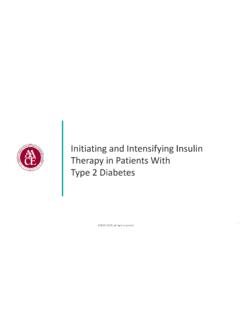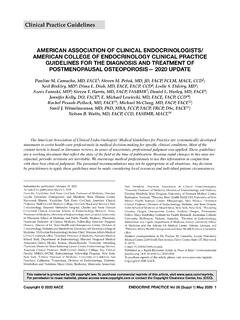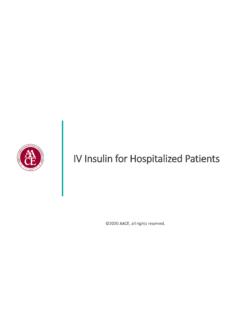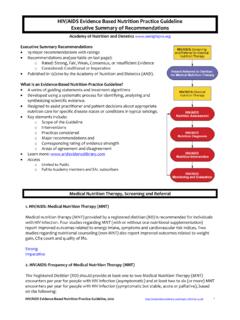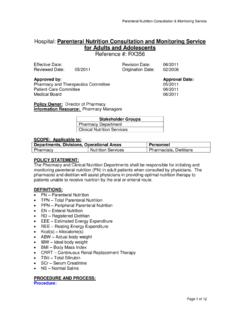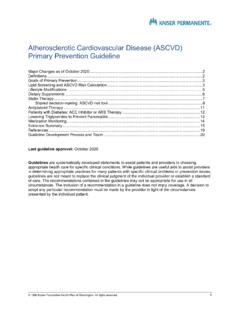Transcription of CONSENSUS STATEMENT BY THE AMERICAN ASSOCIATION …
1 ENDOCRINE PRACTICE Vol 26 No. 10 October 2020 1 AACE/ACE CONSENSUS StatementCONSENSUS STATEMENT BY THE AMERICAN ASSOCIATION OF CLINICAL ENDOCRINOLOGISTS AND AMERICAN COLLEGE OF ENDOCRINOLOGY ON THE MANAGEMENT OF DYSLIPIDEMIA AND PREVENTION OF CARDIOVASCULAR DISEASE ALGORITHM 2020 EXECUTIVE SUMMARYY ehuda Handelsman, MD, Chair1; Paul S. Jellinger, MD, Co-Chair2; Chris K. Guerin, MD, Co-Chair3; Zachary T. Bloomgarden, MD4; Eliot A. Brinton, MD5; Matthew J. Budoff, MD6; Michael H. Davidson, MD7; Daniel Einhorn, MD8; Sergio Fazio, MD9; Vivian A. Fonseca, MD10; Alan J. Garber, MD, PhD11; George Grunberger, MD12; Ronald M. Krauss, MD13; Jeffrey I. Mechanick, MD14; Paul D. Rosenblit, MD, PhD15; Donald A. Smith, MD, MPH16; Kathleen L. Wyne, MD, PhD17 Submitted for publication July 18, 2020 Accepted for publication August 10, 2020 From the 1 Medical Director & Principal Investigator, Metabolic Institute of America, Tarzana, California, 2 Professor of Clinical Medicine, Voluntary Faculty, University of Miami Miller School of Medicine, Center for Diabetes & Endocrine Care, Hollywood, Florida, 3 Clinical Assistant Professor of Medicine, Voluntary Faculty, University of California San Diego, San Diego, California, 4 Editor, the Journal of Diabetes, Clinical Professor, Icahn School of Medicine at Mount Sinai, New York, New York, 5 President, Utah Lipid Center, Salt Lake City, Utah, Past President, AMERICAN Board of Clinical Lipidology, 6 Professor of Medicine.
2 UCLA Endowed Chair of Preventive Cardiology, Los Angeles Biomedical Research Institute, Torrance, California, 7 Professor, Director of the Lipid Clinic, University of Chicago Pritzker School of Medicine, Chicago, Illinois, 8 Associate Editor, the Journal of Diabetes, Medical Director, Scripps Whittier Diabetes Institute, Clinical Professor of Medicine, UCSD, President, Diabetes and Endocrine Associates, San Diego, California, 9 The William and Sonja Connor Chair of Preventive Cardiology, Professor of Medicine and Physiology & Pharmacology, Director, Center for Preventive Cardiology, Knight Cardiovascular Institute, Oregon Health & Science University, Portland, Oregon, 10 Professor of Medicine and Pharmacology, Assistant Dean for Clinical Research, Tullis Tulane Alumni Chair in Diabetes, Chief, Section of Endocrinology, Tulane University Health Sciences Center, New Orleans, Louisiana, 11 Professor, Departments of Medicine, Biochemistry and Cell and Molecular Biology, Baylor College of Medicine, Houston, Texas, 12 Chairman, Grunberger Diabetes Institute, Clinical Professor, Internal Medicine and Molecular Medicine & Genetics, Wayne State University School of Medicine, Professor, Internal Medicine, Oakland University William Beaumont School of Medicine, Visiting Professor, Internal Medicine, First Faculty of Medicine, Charles University, Prague, Czech Republic, Past President.
3 This document represents the official position of the AMERICAN ASSOCIATION of Clinical Endocrinologists and AMERICAN College of Endocrinology. Where there were no randomized controlled trials or specific United States Food and Drug Administration (FDA) labeling for issues in clinical practice, the participating clinical experts utilized their judgment and experience. Every effort was made to achieve CONSENSUS among the committee members. Position statements are meant to provide guidance, but they are not to be considered prescriptive for any individual patient and cannot replace the judgment of a ASSOCIATION of Clinical Endocrinologists, Bloomfield Hills, Michigan, 13 Professor of Pediatrics and Medicine, UCSF, Adjunct Professor, Department of Nutritional Sciences, University of California, Berkeley, Dolores Jordan Endowed Chair, UCSF Benioff Children s Hospital Oakland, 14 Professor of Medicine, Medical Director, The Marie-Josee and Henry R.
4 Kravis Center for Clinical Cardiovascular Health at Mount Sinai Heart, Director, Metabolic Support, Divisions of Cardiology and Endocrinology, Diabetes and Bone Disease, Icahn School of Medicine at Mount Sinai Heart, Director, Metabolic Support, Divisions of Cardiology and Endocrinology, Diabetes and Bone Disease, Icahn School of Medicine at Mount Sinai, New York, New York, 15 Clinical Professor, Medicine (Division of Endocrinology, Diabetes, Metabolism), University California, Irvine, School of Medicine, Irvine, California, Co-Director, Diabetes Out-Patient Clinic, UCI Medical Center, Orange, California, Director & Site Principal Investigator, Diabetes/Lipid Management & Research Center, Huntington Beach, California, 16 Endocrinologist, Clinical Lipidologist, Associate Professor of Medicine, Icahn School of Medicine Mount Sinai, Director Lipids and Metabolism, Mount Sinai Heart, New York, New York, 17 Director, Adult Type 1 Diabetes Program, Division of Endocrinology, Diabetes, and Metabolism, The Ohio State University Wexner Medical Center, Columbus, correspondence to Dr.
5 Yehuda Handelsman, Medical Director & Principal Investigator, Metabolic Institute of America, 18372 Clark Street, #212, Tarzana, CA : as a Rapid Electronic Article in Press at DOI: purchase reprints of this article, please visit: 2020 Lipid Management Algorithm, Endocr Pract. 2020;26(No. 10)ABSTRACT The treatment of lipid disorders begins with lifestyle therapy to improve nutrition, physical activity, weight, and other factors that affect lipids. Secondary causes of lipid disorders should be addressed, and pharmacologic therapy initiated based on a patient s risk for atherosclerotic cardio-vascular disease (ASCVD). Patients at extreme ASCVD risk should be treated with high-intensity statin therapy to achieve a goal low-density lipoprotein cholesterol (LDL-C) of <55 mg/dL, and those at very high ASCVD risk should be treated to achieve LDL-C <70 mg/dL.
6 Treatment for moderate and high ASCVD risk patients may begin with a moderate-intensity statin to achieve an LDL-C <100 mg/dL, while the LDL-C goal is <130 mg/dL for those at low risk. In all cases, treatment should be intensified, includ-ing the addition of other LDL-C-lowering agents ( , proprotein convertase subtilisin/kexin type 9 inhibitors, ezetimibe, colesevelam, or bempedoic acid) as needed to achieve treatment goals. When targeting triglyceride levels, the desirable goal is <150 mg/dL. Statin therapy should be combined with a fibrate, prescription-grade omega-3 fatty acid, and/or niacin to reduce triglycerides in all patients with triglycerides 500 mg/dL, and icosapent ethyl should be added to a statin in any patient with established ASCVD or diabetes with 2 ASCVD risk factors and triglycerides between 135 and 499 mg/dL to prevent ASCVD events.
7 Management of additional risk factors such as elevated lipoprotein(a) and statin intolerance is also :AACE = AMERICAN ASSOCIATION of Clinical Endocrinologists; ACE = AMERICAN College of Endocrinology; ACS = acute coronary syndrome; apo B = apolipoprotein B; ASCVD = atheroscle-rotic cardiovascular disease; BA = bempedoic acid; CAC = coronary artery calcium; CHD = coronary heart disease; CK = creatine kinase; CKD = chronic kidney disease; DHA = docosahexaenoic acid; EPA = eicosapentaenoic acid; FCS = familial chylomicrone-mia syndrome; FDA = United States Food and Drug Administration; FOURIER = Further Cardiovascular Outcomes Research with PCSK9 Inhibition in Subjects with Elevated Risk; HDL-C = high-density lipoprotein cholesterol; HeFH = heterozygous familial hypercho-lesterolemia; HoFH = homozygous familial hyper-cholesterolemia; hsCRP = high-sensitivity C reac-tive protein; IDL = intermediate-density lipoproteins; IMPROVE-IT = Improved Reduction of Outcomes: Vytorin Efficacy International Trial; IPE = icosapent ethyl; LDL-C = low-density lipoprotein cholesterol; Lp(a) = lipoprotein a; MACE = major adverse cardio-vascular events; MI = myocardial infarction; OSA = obstructive sleep apnea; PCSK9 = proprotein conver-tase subtilisin/kexin type 9.
8 REDUCE-IT = Reduction of Cardiovascular Events with EPA-Intervention Trial; UKPDS = United Kingdom Prospective Diabetes Study; = United States; VLDL = very-low-density lipoproteinsEXECUTIVE SUMMARY This algorithm for the comprehensive management of dyslipidemia and prevention of cardiovascular disease (CVD) complements the 2017 AMERICAN ASSOCIATION of Clinical Endocrinologists/ AMERICAN College of Endocrinology (AACE/ACE) Guidelines for Management of Dyslipidemia and Prevention of Cardiovascular Disease (1) and provides clinicians with a practical guide that considers the whole patient, their spectrum of risks and complications, and evidence-based approaches to treat-ment. However, the algorithm has incorporated newer data that were not available when the 2017 guidelines were drafted but which are necessary for contemporary lipid management.
9 Despite recent improvements in the overall rates of lipid disorders and heart disease, atherosclerotic cardiovascular disease (ASCVD) remains the leading cause of death throughout the world (2,3). In the United States ( ), coronary heart disease (CHD), heart failure, and stroke together affect million people (9% of the population), and 29% and 26% of adults have elevations in low-density lipoprotein cholesterol (LDL-C) and triglyc-erides, respectively, putting them at risk of major adverse cardiovascular events (MACE) (3,4). Controlling atherogenic cholesterol particle concen-trations is fundamental to prevention of ASCVD, includ-ing CHD (5). However, only a small percentage of the population who clearly would benefit from a statin ( , hydroxymethylglutaryl-coenzyme A [HMG-CoA] reduc-tase inhibitor) currently takes one (6).
10 Moreover, the aver-age LDL-C among adults, 112 mg/dL (3), is higher than the recommended LDL-C goal of <100 mg/dL for those with moderate ASCVD risk and well above the goals for people at high risk of ASCVD (1). Risk factors for dyslipidemia, including obesity, chronic kidney disease (CKD), and diabetes, have risen steadily over recent decades and are expected to continue to increase (7-9). Most notably, 44% of adults now have obesity (defined by a body mass index [BMI] >30 kg/m2), without any difference in the proportions of younger versus older adults (7). Early exposure to elevated lipids, prior to age 55 years, has a greater impact on CHD risk than do elevations later in life (10), indicating that care-ful management of patients with dyslipidemia is important across the lifespan.

